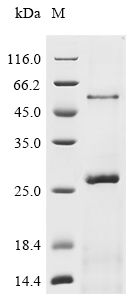Recombinant Bat coronavirus HKU3 Spike glycoprotein (S) is produced in E. coli and covers amino acids 310-514. This partial protein carries an N-terminal 6xHis-tag, which streamlines purification and detection processes. SDS-PAGE analysis confirms the product achieves greater than 90% purity, making it well-suited for research work.
The Spike glycoprotein (S) of Bat coronavirus HKU3 appears to play a critical role in how the virus enters cells. It mediates both attachment and fusion between viral and host cell membranes. This makes it a key target for investigating viral infection mechanisms and potentially developing therapeutic interventions. Research into coronavirus-host interactions and viral pathogenesis likely depends on understanding this protein.
Potential Applications
Note: The applications listed below are based on what we know about this protein's biological functions, published research, and experience from experts in the field. However, we haven't fully tested all of these applications ourselves yet. We'd recommend running some preliminary tests first to make sure they work for your specific research goals.
1. Comparative Spike Protein Structure-Function Studies
This recombinant fragment (310-514 aa) from the bat coronavirus HKU3 spike protein may serve as a tool for comparative structural studies, but results must be interpreted with caution due to potential misfolding. The E. coli expression system lacks eukaryotic post-translational modifications and proper disulfide bond formation critical for coronavirus spike protein structure. While techniques like circular dichroism can provide secondary structure information, data from surface plasmon resonance or crystallography may not reflect native conformation. Comparative analyses with other coronavirus spike proteins should be validated with mammalian-expressed controls.
2. Antibody Development and Cross-Reactivity Screening
This protein can generate antibodies, but they may not recognize the native spike protein due to likely misfolding in E. coli. Antibodies developed against this antigen might primarily recognize linear epitopes rather than conformational epitopes present on the authentic viral spike protein. Cross-reactivity studies using this antigen will have limited biological relevance for understanding neutralization or immune recognition of properly folded spike protein.
3. Protein-Protein Interaction Studies
Pull-down assays using this protein are likely to yield non-physiological interactions due to probable misfolding. The inability of the E. coli-expressed protein to adopt correct tertiary structure means identified binding partners may not reflect genuine biological interactions. Any potential receptors identified would require extensive validation with properly folded protein from eukaryotic expression systems.
4. Biochemical Characterization and Stability Studies
This protein is suitable for basic biochemical characterization, but the results will characterize the properties of the misfolded recombinant protein, not the native spike protein. Stability parameters (thermal stability, pH sensitivity) determined using this protein may not translate to the biologically relevant form and could be misleading for understanding actual viral protein behavior.
Final Recommendation & Action Plan
This E. coli-expressed bat coronavirus HKU3 spike protein fragment has significant limitations for biologically meaningful studies due to the high probability of misfolding. Priority should be given to validating the protein's structural state using circular dichroism spectroscopy and comparing it with properly folded standards. For reliable results, consider switching to a eukaryotic expression system (baculovirus or mammalian cells) that can support proper glycosylation and folding. If using this protein, limit applications to initial screening or linear epitope mapping, and clearly acknowledge the folding limitations in all research outcomes. For functional studies, always validate key findings with proteins expressed in more appropriate systems that preserve native spike protein conformation.






